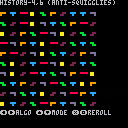Sometimes, your game makes use of a randomly generated sequence, but it would be nice to smooth out some of the short-term variance in it (e.g. long stretches of not getting a long piece in Tetris). This cart showcases some algorithms you can use to generate smoother-feeling random sequences, and lets you visualize them for tetrominoes, digits, or dice rolls.
Thanks to TetrisConcept without whom I would never have learned about these techniques, and to the developers who invented them.
See the code comments for more on the implementation of each randomizer.

This is really WAY over my head, DrPete. But checking your code I can see you are doing a vast number of ways to get random values, and to get them based on conditions, restrictions, and evictions. :)
If you're curious, you might use some line charts to graph out patterns found in your methods.

--makes a table from 0 to (to)
function range(to)
local array={}
for i=1,to do
array[i]=i-1
end
return array
end
--returns a table with index (v) removed from table (t)
function pop(t,v)
local array={}
local index=1
for i=1,#t-1 do
if(i==v)then
index+=1
end
array[i]=t[index]
index+=1
end
return array
end
--settings
local old=nil
local size=10
--makes a table from 0 to (size)
--pops out (old) from table
--takes out a random element from table
function randommemory()
if(old==nil)then
local take=flr(rnd(size))
old=take
return take
else
local selectable=range(size)
selectable=pop(selectable,old+1)
local take=flr(rnd(#selectable))
old=selectable[take+1]
return selectable[take+1]
end
end
--takes one from 0 to (size)
--if the value is equal to (old) then repeat
function randomloop()
while(true)do
local take=flr(rnd(size))
if(take~=old)then
old=take
return take
end
end
end
--printing out
for i=1,10 do
print(randomloop())
end
|

Anastasia, I am looking at your link. Are you just wanting to plot colored dots where no colored dot matches the one next to it either above, below, left, or right ?

Left and above. Below and right doesn't really matter because it loops from top left to bottom right. It would matter if the cells were placed randomly in order. You would need to push {x:-1,y:-1},{x:1,y:-1} into neighbourPositions for diagonal checking.


That's pretty good.
It would be
(x==0 or scr[i-1]!=c) and scr[i-15]!=c and (y==0 or scr[i-16]!=c) and scr[i-17]!=c |
right? Or even shorter for diagonal checking?

[Please log in to post a comment]











